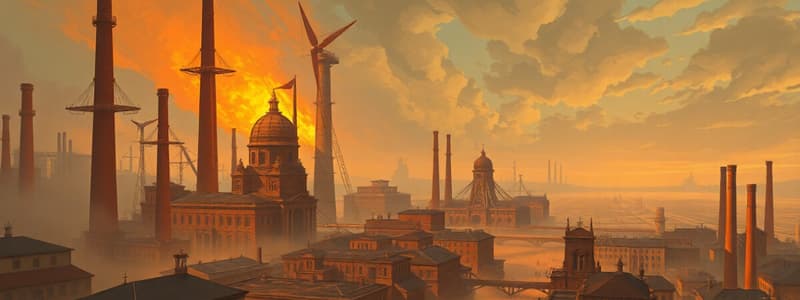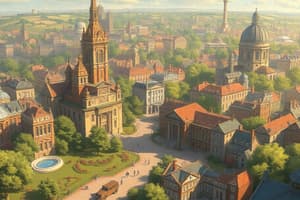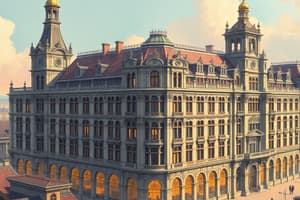Podcast
Questions and Answers
What are the three fundamental elements that Emerson believes nature provides?
What are the three fundamental elements that Emerson believes nature provides?
- Truth, goodness, and beauty (correct)
- Wisdom, harmony, and love
- Sustainability, peace, and joy
- Strength, knowledge, and creativity
Which concept did Patrick Geddes introduce through his work 'Cities in Evolution'?
Which concept did Patrick Geddes introduce through his work 'Cities in Evolution'?
- Regional planning (correct)
- Modern architecture
- Environmental sustainability
- Socialist urbanization
What shape did Geddes propose for urban planning in order to integrate nature into city life?
What shape did Geddes propose for urban planning in order to integrate nature into city life?
- Grid pattern
- Circular layout
- Spiral design
- Star-shaped form (correct)
Which natural feature did Geddes consider important for city planning and urban development?
Which natural feature did Geddes consider important for city planning and urban development?
What does Geddes' 'Valley Section' model represent?
What does Geddes' 'Valley Section' model represent?
What were some of the environmental and social conditions experienced during the liberal period of capitalism in the 19th century?
What were some of the environmental and social conditions experienced during the liberal period of capitalism in the 19th century?
What does the term 'pre-urban planning' refer to?
What does the term 'pre-urban planning' refer to?
Which of the following describes the impact of industrial development on the workforce during the 19th century?
Which of the following describes the impact of industrial development on the workforce during the 19th century?
What was one significant consequence of uncontrolled development in cities during industrialization?
What was one significant consequence of uncontrolled development in cities during industrialization?
What does F. Choay identify as the two stages related to urban planning?
What does F. Choay identify as the two stages related to urban planning?
What was Robert Owen's role in the cooperative movement?
What was Robert Owen's role in the cooperative movement?
What was the primary goal of Robert Owen's New Harmony community?
What was the primary goal of Robert Owen's New Harmony community?
How many inhabitants was the New Harmony community designed to support?
How many inhabitants was the New Harmony community designed to support?
What was the main feature of the architectural design of New Harmony?
What was the main feature of the architectural design of New Harmony?
In which year did Charles Fourier publish his work 'Le Phalanstere'?
In which year did Charles Fourier publish his work 'Le Phalanstere'?
What was a significant aspect of Fourier's proposal for phalanstères?
What was a significant aspect of Fourier's proposal for phalanstères?
What types of facilities were included in the New Harmony community?
What types of facilities were included in the New Harmony community?
What was one of Robert Owen's proposals regarding work hours?
What was one of Robert Owen's proposals regarding work hours?
Which group is most associated with the idea of maintaining traditional social bonds in urban planning?
Which group is most associated with the idea of maintaining traditional social bonds in urban planning?
What approach did progressives favor in response to the challenges of the industrial revolution?
What approach did progressives favor in response to the challenges of the industrial revolution?
Which of the following best describes the vision of the progressive model regarding city organization?
Which of the following best describes the vision of the progressive model regarding city organization?
Which of the following thinkers is NOT associated with the progressive model of urban planning?
Which of the following thinkers is NOT associated with the progressive model of urban planning?
What aspect of the progressive model reflects a critical view of industrial society?
What aspect of the progressive model reflects a critical view of industrial society?
What did naturalists believe about the natural world?
What did naturalists believe about the natural world?
What is a key characteristic of the urban forms proposed by socialist utopians?
What is a key characteristic of the urban forms proposed by socialist utopians?
Which urban planning group emphasizes returning to a more village-like form of living?
Which urban planning group emphasizes returning to a more village-like form of living?
Which of the following factors did naturalists criticize about industrial cities?
Which of the following factors did naturalists criticize about industrial cities?
What role did hygiene play in the progressive model of urban planning?
What role did hygiene play in the progressive model of urban planning?
What role did Frank Lloyd Wright play in relation to the naturalist movement?
What role did Frank Lloyd Wright play in relation to the naturalist movement?
How did Thoreau view the relationship between humanity and nature?
How did Thoreau view the relationship between humanity and nature?
What did Thoreau identify as essential needs for human life?
What did Thoreau identify as essential needs for human life?
What did naturalists believe about the urban environment?
What did naturalists believe about the urban environment?
What was a key philosophy of Thoreau regarding society?
What was a key philosophy of Thoreau regarding society?
What impact did the naturalist movement have on American culture?
What impact did the naturalist movement have on American culture?
What foundational aspect does Unwin emphasize for urban planning?
What foundational aspect does Unwin emphasize for urban planning?
Which artistic movement is Unwin associated with?
Which artistic movement is Unwin associated with?
Who is considered a major influence on Unwin's concepts of residential communities?
Who is considered a major influence on Unwin's concepts of residential communities?
Which perspective does Unwin align with that developed at the end of the 19th century?
Which perspective does Unwin align with that developed at the end of the 19th century?
What is a key component of Unwin's vision of city planning?
What is a key component of Unwin's vision of city planning?
What utopian vision does Unwin embrace?
What utopian vision does Unwin embrace?
Which garden city theorist inspired Unwin's ideas?
Which garden city theorist inspired Unwin's ideas?
What kind of approach towards nature does Unwin promote in urban planning?
What kind of approach towards nature does Unwin promote in urban planning?
Which of the following is NOT a characteristic of the progressive model compared to culturalist models?
Which of the following is NOT a characteristic of the progressive model compared to culturalist models?
How does Unwin view the relationship between urban design and social needs?
How does Unwin view the relationship between urban design and social needs?
Flashcards
Liberal Period of Capitalism (19th Century)
Liberal Period of Capitalism (19th Century)
The period of rapid industrial growth and urbanization in the 19th century, characterized by new factories, increasing populations in cities, and poor living conditions.
Migration from Countryside to Towns
Migration from Countryside to Towns
The process of moving from rural areas to urban areas, often driven by economic opportunities.
Industrial Cities
Industrial Cities
Major cities that emerged during the Industrial Revolution, often characterized by rapid growth, overcrowding, and industrial pollution.
Uncontrolled Development of Cities
Uncontrolled Development of Cities
Signup and view all the flashcards
Social Utopia
Social Utopia
Signup and view all the flashcards
Progressive Urbanism
Progressive Urbanism
Signup and view all the flashcards
Socialist Utopia
Socialist Utopia
Signup and view all the flashcards
Rational City Planning
Rational City Planning
Signup and view all the flashcards
Progress in Urbanism
Progress in Urbanism
Signup and view all the flashcards
Functionalist City Planning
Functionalist City Planning
Signup and view all the flashcards
Hygienic City Planning
Hygienic City Planning
Signup and view all the flashcards
Collective Housing in Urbanism
Collective Housing in Urbanism
Signup and view all the flashcards
Repressive Aspects of Progressive Urbanism
Repressive Aspects of Progressive Urbanism
Signup and view all the flashcards
What is the 'Valley Section'?
What is the 'Valley Section'?
Signup and view all the flashcards
What is Patrick Geddes' view on city design?
What is Patrick Geddes' view on city design?
Signup and view all the flashcards
Why did Patrick Geddes favor 'river basins' for urban development?
Why did Patrick Geddes favor 'river basins' for urban development?
Signup and view all the flashcards
What is Patrick Geddes' theory of societies and cities?
What is Patrick Geddes' theory of societies and cities?
Signup and view all the flashcards
Who is Patrick Geddes?
Who is Patrick Geddes?
Signup and view all the flashcards
Naturalism
Naturalism
Signup and view all the flashcards
Naturalist Critique of the Industrial City
Naturalist Critique of the Industrial City
Signup and view all the flashcards
Thoreau's Concept of Isolation in Nature
Thoreau's Concept of Isolation in Nature
Signup and view all the flashcards
Thoreau's Four Essential Needs
Thoreau's Four Essential Needs
Signup and view all the flashcards
American Naturalism
American Naturalism
Signup and view all the flashcards
Naturalist Urbanism
Naturalist Urbanism
Signup and view all the flashcards
Voluntary Simplicity
Voluntary Simplicity
Signup and view all the flashcards
Degrowth
Degrowth
Signup and view all the flashcards
Robert Owen
Robert Owen
Signup and view all the flashcards
New Harmony
New Harmony
Signup and view all the flashcards
Charles Fourier
Charles Fourier
Signup and view all the flashcards
Phalanstere
Phalanstere
Signup and view all the flashcards
Three-hour workday
Three-hour workday
Signup and view all the flashcards
Rigid framework of values and lifestyles
Rigid framework of values and lifestyles
Signup and view all the flashcards
Improvement of the human being through education and environment
Improvement of the human being through education and environment
Signup and view all the flashcards
Division of labor
Division of labor
Signup and view all the flashcards
Who was Raymond Unwin?
Who was Raymond Unwin?
Signup and view all the flashcards
What was Unwin's approach to urban planning?
What was Unwin's approach to urban planning?
Signup and view all the flashcards
How did Unwin's approach align with culturalist perspectives?
How did Unwin's approach align with culturalist perspectives?
Signup and view all the flashcards
Who influenced Unwin's ideas?
Who influenced Unwin's ideas?
Signup and view all the flashcards
How was Unwin influenced by the Arts and Crafts movement?
How was Unwin influenced by the Arts and Crafts movement?
Signup and view all the flashcards
How did the garden city theory influence Unwin?
How did the garden city theory influence Unwin?
Signup and view all the flashcards
What were Unwin's goals for urban planning?
What were Unwin's goals for urban planning?
Signup and view all the flashcards
How did Unwin's views differ from the 'progressive' model of urban planning?
How did Unwin's views differ from the 'progressive' model of urban planning?
Signup and view all the flashcards
What was Hampstead Garden City?
What was Hampstead Garden City?
Signup and view all the flashcards
What key factors did Unwin emphasize in urban planning?
What key factors did Unwin emphasize in urban planning?
Signup and view all the flashcards
Study Notes
Urban Utopias of the 19th Century
- 19th-century urban development was marked by rapid industrialization, rural-to-urban migration, and the creation of new industrial cities. This led to significant environmental and social problems such as pollution, poor sanitation, overcrowding, and worker exploitation.
- The chaos of industrialization prompted protests and new urban perspectives, giving rise to utopian thinkers who sought to address these problems with various solutions
- Pre-urban planning predates the term itself and represents a set of texts and achievements by social and political thinkers of the 19th century. These thinkers prefigured the approach of urban planning.
Progressive Model
- Progressive pre-urbanist authors, often inspired by socialism, aimed to resolve the "social question."
- They sought solutions to the chaotic industrial city of the time and advocated for formal solutions.
- They proposed ideal city forms, often emphasizing rationality, science, and technology.
- They believed in a universal man-type and rationality, and used science and technology.
- Examples include Charles Fourier and Robert Owen, each with their own unique approaches to city design.
Culturalist Model
- In contrast to the progressive model's focus on geometry, the culturalist model emphasized heterogeneity.
- It looked toward the past, specifically medieval cities, and emphasized preserving the organic unity of the culture
- The culturalist model celebrated the natural beauty and irregularity.
- Figures such as Camillo Sitte, and John Ruskin were advocates of reviving medieval urban forms that prioritized tradition and human-scale design. They sought to craft cities that reflected a culture's history and values.
Naturalist Model
- This model critiqued the industrial city as isolating and dehumanizing, placing emphasis on nature and its integration with urban design.
- Naturalists valued the natural environment, advocating for the separation from and isolation of individuals in nature, away from industrialization and its impacts.
- Figures such as Henry David Thoreau and Ralph Waldo Emerson were influential in this movement.
Key Figures and their Works
- Robert Owen (1771-1858): Founder of New Harmony, a utopian social experiment in the United States, aimed at improving the quality of life for the working class.
- Charles Fourier (1772-1857): Advocated for phalansteres, communal living arrangements designed to foster harmony and cooperation.
- Jean Baptiste Godin (1817-1888): Created the Familistère at Guise, France, a worker cooperative housing complex with social amenities.
- Augustin Welby Northmore Pugin (1812-1852): Neo-Gothic architect who critiqued modern urban designs and emphasized the beauty of medieval architecture.
- John Ruskin (1819-1900): Art critic influential in emphasizing the importance of tradition and the negative aspects of industrialization, and promoted the Arts and Crafts movement.
- Camillo Sitte (1843-1903) and Ebenezer Howard: Advocated for "organic" cities adapted to local conditions rather than large-scale, grid-pattern cities, as well as the development of modern theories of spatial planning and regional planning.
Other Key Concepts
- The "Social Question": Term referring to the social problems, poverty, and inequality created by industrialization and urbanization.
- City as a reflection of culture: The idea that the city embodies the culture and history of its inhabitants.
- Garden city movement: Social and environmental movement emerged, which aimed to create planned residential communities, integrating nature with urban development.
- Urban Utopias were ideals of how cities could be planned to maximize the well-being of their inhabitants, often reflecting particular philosophies of what a good society should look like.
Studying That Suits You
Use AI to generate personalized quizzes and flashcards to suit your learning preferences.




